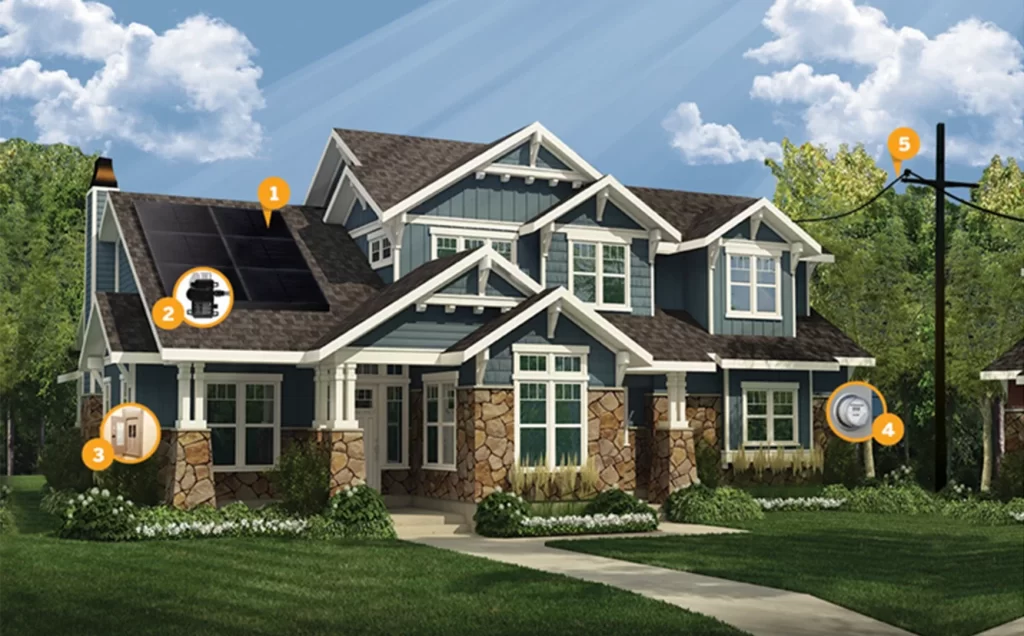The power to harness sunshine and turn it into electricity is no longer science fiction – 5 million American roofs prove it. Solar panels on your house convert sunlight into electricity through a process called the photovoltaic effect, a technology that has become more efficient as time has gone on. Your roof-mounted solar panels contain photovoltaic (PV) cells that capture sunlight and convert it into direct current (DC) that then must be converted to alternating current (AC) for home use. The excess energy created from those solar panels can be stored in batteries for later use or sent back to the grid for reduced energy costs for you and a lower environmental impact for all. Are you thinking about solar energy for your home? Understanding the science can help you decide whether home solar energy is worth it.
The Science Behind Solar Power for Homes
Your home solar system begins with panels mounted on your roof. These are the large, dark, reflective panels you see on homes and buildings in your town. Each solar panel contains photovoltaic cells made of silicon layers that create an electric field. When sunlight hits these cells, it knocks electrons loose to generate direct current (DC) electricity. DC power creates continuous, strong current that generates more heat, and poses more hazards than AC power. Your home runs on AC current so you need an inverter to turn DC power into AC electricity to power your home’s appliances and systems.

Image guide: 1-Solar panel or module, 2-Inverter, 3-Electrical panel or Main panel, 4-Utility meter, 5-Utility line (where any electricity not used goes back into the grid)
Key Components of Your Home Solar System
Your residential solar setup is made up of several essential parts, some of the most important include:
- Solar Panels: capture the sunlight
- Inverter: converts DC to AC power; generally mounted near your electrical panel or on an exterior wall
- Electric Meter: bi-directional to track both the power you use and the excess electricity your system sends back to the grid
- Electrical Breaker System: safety mechanism that protects your system from damage from overloads, short circuits, or ground faults
- Charge Control: controls the flow of energy between the panels and the batteries, ensuring they are properly charged
- Batteries: store energy for later use, especially when there isn’t enough sunlight hitting the panels
- Mounting Brackets: secure the solar panels to the roof so they stay put in rain, storm, wind, or sunshine
Storing Solar Energy at Your Home
Batteries in solar systems store excess electricity generated by solar panels for use when sunlight is unavailable, such as at night or during power outages. They store energy as DC, which an inverter converts to AC for home use. Batteries improve energy independence, reduce reliance on the grid, and provide backup power. Common battery types include lithium-ion and lead-acid, with lithium-ion being more efficient and longer-lasting. Battery storage helps maximize solar efficiency by ensuring energy availability even on cloudy days, enhancing sustainability and cost savings by reducing dependence on traditional utility power sources. And any excess electricity can flow back to the power grid, which can earn you credits through net metering programs – a system that helps solar homeowners save annually on electricity costs.
What Happens with Home Solar Energy Systems on Cloudy Days?
While panels produce more electricity on bright days, they still maintain significant output in less-than-ideal conditions. In fact, solar panels can still produce 10-25% of their optimal output on cloudy days.
Sunny states like California with 300+ days of sun may seem ideal for solar, but even states with much less sun can benefit as well. For example, in a state like New Jersey or Pennsylvania, your home’s solar energy system likely produces more power during summer months, but you can bank credits for winter use through net metering programs. But, even with significant snow buildup on roofs, energy loss is only estimated to be about 3%.
Home Solar Energy System Maintenance and Longevity
Solar panels last decades, and most manufacturers offer long-term warranties. Your system needs minimal maintenance, but just like the vehicles you drive daily, regular care will optimize its performance and lifespan. The National Renewable Energy Laboratory recommends annual inspections to check for debris, damage, or loose connections. You may also need to clean your panels once a year, but rain often takes care of this for you, naturally. Professional cleaning services exist but rarely become necessary unless you live in a particularly dusty area or notice significant performance decline.
Is Your Home Solar-Ready?
Consider these factors to determine if residential solar will work well for your home:
- Roof Direction: South-facing roofs capture the most sunlight.
- Shade Coverage: Trees or nearby buildings affect panel efficiency, so if you’re surrounded by trees or close to other buildings or homes, you may need to look for alternative arrangements.
- Roof Age: You shouldn’t put solar panels on an old or failing roof, so factor that in if your roof is on its last shingles.
- Local Regulations: Check your municipality’s solar installation requirements, as standards differ depending on where you live.
You may not know the answer to any of these considerations. But ShopSolar.ai does! Give us a call today at (866) 50-SOLAR and we’ll answer any questions you have.




